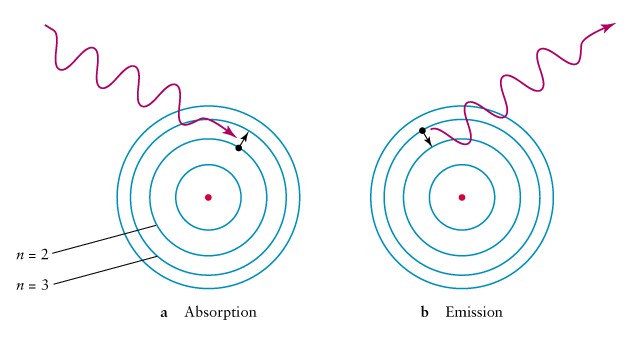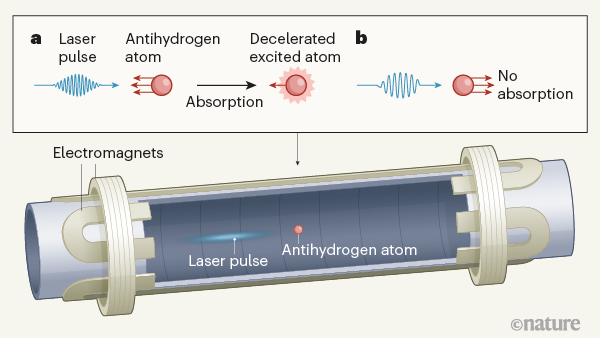Nature is a weird entity.
Spewing incomprehensible anomalies and unfathomable mysteries in every nook and corner, the universe does really offer a challenge to the people trying to make sense of it. The theories, no matter how accurate they seem to be, are gullible to the tricks of nature. So physicists always look for newer and better ways to test the theories. With advancements in technology, today, we are able to test our theories to unprecedented accuracies and are able to fine-tune our understanding of how the universe works.
On 31st March, the Antihydrogen Laser PHysics Apparatus (ALPHA) collaboration at CERN successfully cooled down antimatter using lasers, opening the doors to measurements of higher precision, allowing us to further our grasp on the machinery of the world. But how was this achieved?
Antimatter…
In 1928, the genius of Dirac stumbled upon a magnificent equation that brought chaos to the physics world. He produced an entirely correct equation, whose prediction of particles with negative energy contradicted common sense. Most of his colleagues all over the world rejected the theory, calling it absurd and senseless. But nature has its own ways. It turned out that these particles are not only the adhoc of a theory, but they do indeed exist. These particles were called Antiparticles, and they constituted the new family of matter called the antimatter.

[Image: CERN]
Nature worships symmetries, and thus each and every particle in the standard model has its own counterpart, the corresponding antiparticle. These antiparticles are rare to find and difficult to produce because they tend to annihilate as soon as they come in contact with their matter counterpart. The LHC produces these exotic particles by smashing near light-speed particles which form a particle shower producing antiparticles too. Experimentalists at CERN confined antiproton and antielectrons into an antimatter cloud using magnetic fields, causing them to form antihydrogen. After this, the antihydrogen atoms were cooled down by blasting lasers at them.
Cooling…
How do you cool down something using lasers? To understand this, first, we need to understand that temperature is directly related to the velocity of the particles. Motion generates heat, the more kinetic energy the constituent particles of a system has, the more is its temperature. The antiparticles produced in LHC starts out at very large speeds – millions of metres per second, corresponding to very high temperatures. Cooling down these particles essentially means slowing them down. One easy way of doing this would be to immerse the antiparticles in the colder matter, just how you place something in the refrigerator, which is colder than the surroundings, in order to cool it. But in the case of antimatter the antiparticles, instead of cooling down, would interact with the cold matter and get annihilated. So the researchers had to come up with an ingenious method, which includes playing with lasers, to cool them down. Think of the antiparticle as a huge rock advancing at you at a considerable speed. You can slow it down by firing a very large number of bullets at it, the photons, which impart momentum to the antiparticle in the direction opposite to its motion, essentially slowing it down.
The quantum phenomena…
Unlike a classical rock which can be touched by all bullets fired at it, the antiparticle is a quantum particle and hence only photons of a certain frequency can be absorbed by it. This frequency corresponds to the energy required to excite the anti-electron from the ground state to any of the excited states. Photons of any other frequency do not affect the antiparticle at all. The anti-electron absorbs the photon, jumping to a higher energy level (the excited state) and then emits a photon in some random direction returning back to the ground state. From the conservation of momentum, the antiparticle must now have a velocity slower than the initial velocity it had. Repeating this for a few hours can slow down the antiparticle considerably.

[Image: Socratic]
The doppler effect ….
The one challenge the team faced now was to eliminate the unnecessary speeding up of antiparticles moving in the opposite direction, i.e. in the same direction as that of the photons of the laser beam. To this, they took advantage of the Doppler effect.
Doppler effect is the most common, but the most useful effect in physics. In simple words, if you are moving towards a source of a wave then the wave appears to have a shorter wavelength and a higher frequency, and if you are moving away from the source of the wave it appears to have a longer wavelength and hence smaller frequency. Since the antiparticles to be cooled down is moving towards the laser beam, it sees the photons as having a higher frequency, and the antiparticle moving in the opposite direction sees it as having a lower frequency. If the laser frequency is carefully set, the beam to be cooled down will see the photon to be of the exact frequency it can absorb, and the beam in the opposite direction will see a much lower frequency and hence will not absorb it. Thus by fine-tuning the frequency to a bit lower than the allowed frequency, we can selectively allow only the antiparticles to be slowed down to interact with the photons, and the antiparticles moving in opposite direction goes entirely unaffected*.

a-Atoms moving towards the laser experience a Doppler effect that shortens the apparent wavelength of the light that interacts with the atoms; the resulting wavelength exactly matches the photon energy that can be absorbed by the atoms. Photon absorption simultaneously excites the atoms and slows them down (cools them).
b-Atoms that move away from the laser experience the opposite Doppler effect, increasing the apparent wavelength of the UV light. The atoms cannot absorb photons at this wavelength, and the laser beam, therefore, passes through the atoms without causing undesirable acceleration.
[Source: Nature]
After several hours of repeating this, the team observed that the anti-atoms had cooled down considerably, and many of them had attained energies below a microeletronvolt (about 0.012 Kelvin in temperature equivalent*).
This cooling of antimatter has made it possible for physicists to perform new and precise experiments to study the behaviour of antimatter and also to confirm the currently accepted theories. One can drop it to check its interaction with gravity, or shine light on it to study the energy levels of the anti-atom, or check the interference pattern of the antiparticles, one can perform various sorts of experiments to confirm the currently accepted theories of antimatter. In a sense, we can say that the sky is no more a limit, and we have ladders taller than the sky to help us reach beyond the limits.




Excellent blog here! Also your web site loads up fast!
What host are you using? Can I get your affiliate link to your host?
I wish my site loaded up as fast as yours lol
WOW just what I was looking for. Came here by
searching for website